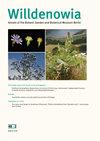The discovery, typification and rediscovery of wild emmer wheat, Triticum turgidum subsp. dicoccoides (Poaceae)
IF 1.4
3区 生物学
Q2 PLANT SCIENCES
引用次数: 0
Abstract
Wild emmer, Triticum turgidum subsp. dicoccoides, is an annual tetraploid wheat characterized by a brittle spike axis that spontaneously disintegrates at maturity. It occurs widely in the so-called Fertile Crescent of the Near East and is of great importance for understanding wheat evolution and for breeding modern wheat cultivars tolerant of extreme heat and dryness. Wild emmer was first collected by Theodor Kotschy on Mt Hermon in Lebanon in 1855, but was not found again for more than half a century. Friedrich August Kornicke was first to realize that Kotschy's specimen represented an ancestral form of hexaploid bread wheat, T. aestivum, but, although he gave it a name, he did not describe it. Paul Ascherson and Paul Graebner were the first to provide a description, basing it on information received in a letter from Kornicke. In doing so, they validated Kornicke's suggested name T. sativum var. dicoccoides and made Kotschy's specimen the holotype. Five years later, on the basis of information received from Ascherson and Georg Schweinfurth in Berlin, Aaron Aaronsohn rediscovered wild emmer on Mt Hermon and started to send specimens for further study to Europe. Soon afterwards he also discovered it east of the river Jordan, while Theodor Strauss collected the first specimens in Iran. This paper focuses on the as yet widely unappreciated herbarium record, listing and commenting on early specimens collected in the wild as well as those cultivated in botanical gardens up to 1910.野生二粒小麦Triticum turgidum subsp的发现、分类和再发现。dicoccoides(禾本科)
野生小麦,小麦亚科。双星小麦是一种一年生四倍体小麦,其特征是成熟时具有脆性穗轴,穗轴会自发解体。它广泛存在于所谓的近东新月沃土,对了解小麦的进化和培育耐受极端高温和干燥的现代小麦品种具有重要意义。1855年,西奥多·科奇(Theodor Kotschy)在黎巴嫩的黑门山上首次发现了野生四分之一,但半个多世纪以来都没有再发现过。弗里德里希·奥古斯特·科尔尼克(Friedrich August Kornicke)是第一个意识到科奇的样本代表了六倍体面包小麦的祖先形式,T. aestivum,但是,尽管他给它起了一个名字,但他没有描述它。保罗·阿舍森(Paul Ascherson)和保罗·格雷伯纳(Paul Graebner)是第一个提供描述的人,他们的描述是根据科尔尼克的一封信中收到的信息。在这样做的过程中,他们证实了科尔尼克提出的T. sativum var. dicoccoides的名称,并使科奇的标本成为了全模标本。五年后,根据从柏林的Ascherson和Georg Schweinfurth那里得到的信息,Aaron Aaronsohn在黑门山上重新发现了野生的emmer,并开始将标本送往欧洲进行进一步的研究。不久之后,他也在约旦河以东发现了它,而西奥多·施特劳斯在伊朗收集了第一批标本。本文重点介绍了尚未得到广泛重视的植物标本室记录,列出并评论了1910年以前在野外采集的早期标本和植物园栽培的标本。
本文章由计算机程序翻译,如有差异,请以英文原文为准。
求助全文
约1分钟内获得全文
求助全文
来源期刊

Willdenowia
PLANT SCIENCES-
CiteScore
4.60
自引率
5.30%
发文量
17
审稿时长
>12 weeks
期刊介绍:
Willdenowia is an international peer-reviewed journal publishing original research articles in English from the entire fields of plant, algal and fungal systematics, covering the evolution, taxonomy and nomenclature of these organisms as well as related fields such as floristics and plant geography. Articles on phylogeny and molecular systematics are especially welcome, as are review articles. Descriptions of new taxa may be considered, but only if supported by robust evidence. Narrowly regional studies of widespread taxa, routine typifications, checklists and new floristic records are generally not considered (excluding contributions to the Euro+Med-Checklist Notulae). Authors are encouraged to deposit duplicates of their material, especially nomenclatural types, in the Berlin herbarium (B).
 求助内容:
求助内容: 应助结果提醒方式:
应助结果提醒方式:


